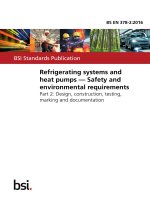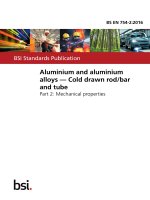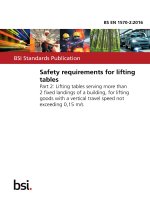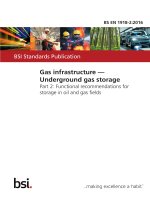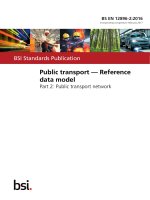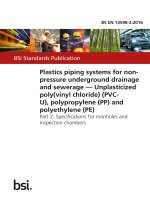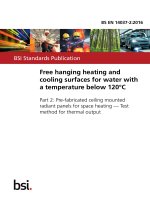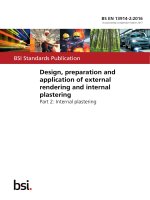Bsi bs en 61189 2 719 2016
Bạn đang xem bản rút gọn của tài liệu. Xem và tải ngay bản đầy đủ của tài liệu tại đây (3.02 MB, 26 trang )
BS EN 61189-2-719:2016
BSI Standards Publication
Test methods for electrical
materials, printed boards and
other interconnection structures
and assemblies
Part 2-719: Test methods for materials for
interconnection structures — Relative
permittivity and loss tangent
(500 MHz to 10 GHz)
BRITISH STANDARD
BS EN 61189-2-719:2016
National foreword
This British Standard is the UK implementation of EN 61189-2-719:2016.
It is identical to IEC 61189-2-719:2016.
The UK participation in its preparation was entrusted to Technical
Committee EPL/501, Electronic Assembly Technology.
A list of organizations represented on this committee can be obtained on
request to its secretary.
This publication does not purport to include all the necessary provisions of
a contract. Users are responsible for its correct application.
© The British Standards Institution 2016.
Published by BSI Standards Limited 2016
ISBN 978 0 580 88266 1
ICS 31.180
Compliance with a British Standard cannot confer immunity from
legal obligations.
This British Standard was published under the authority of the
Standards Policy and Strategy Committee on 31 October 2016.
Amendments/corrigenda issued since publication
Date
Text affected
BS EN 61189-2-719:2016
EUROPEAN STANDARD
EN 61189-2-719
NORME EUROPÉENNE
EUROPÄISCHE NORM
October 2016
ICS 31.180
English Version
Test methods for electrical materials, printed boards and other
interconnection structures and assemblies Part 2-719: Test methods for materials for interconnection
structures - Relative permittivity and loss tangent (500 MHz to 10
GHz)
(IEC 61189-2-719:2016)
Méthode d'essai pour les matériaux électriques, les cartes
imprimées et autres structures d'interconnexion et
ensembles - Partie 2-719: Méthodes d'essai des matériaux
pour structures d'interconnexion - Permittivité relative et
tangente de perte (500 MHz à 10 GHz)
(IEC 61189-2-719:2016)
Prüfverfahren für Elektromaterialien, Leiterplatten und
andere Verbindungsstrukturen und Baugruppen Teil 2-719: Prüfverfahren für Materialien von
Verbindungsstrukturen - Relative Permittivität und
Verlustfaktor (500 MHz bis 10 GHz)
(IEC 61189-2-719:2016)
This European Standard was approved by CENELEC on 2016-08-16. CENELEC members are bound to comply with the CEN/CENELEC
Internal Regulations which stipulate the conditions for giving this European Standard the status of a national standard without any alteration.
Up-to-date lists and bibliographical references concerning such national standards may be obtained on application to the CEN-CENELEC
Management Centre or to any CENELEC member.
This European Standard exists in three official versions (English, French, German). A version in any other language made by translation
under the responsibility of a CENELEC member into its own language and notified to the CEN-CENELEC Management Centre has the
same status as the official versions.
CENELEC members are the national electrotechnical committees of Austria, Belgium, Bulgaria, Croatia, Cyprus, the Czech Republic,
Denmark, Estonia, Finland, Former Yugoslav Republic of Macedonia, France, Germany, Greece, Hungary, Iceland, Ireland, Italy, Latvia,
Lithuania, Luxembourg, Malta, the Netherlands, Norway, Poland, Portugal, Romania, Slovakia, Slovenia, Spain, Sweden, Switzerland,
Turkey and the United Kingdom.
European Committee for Electrotechnical Standardization
Comité Européen de Normalisation Electrotechnique
Europäisches Komitee für Elektrotechnische Normung
CEN-CENELEC Management Centre: Avenue Marnix 17, B-1000 Brussels
© 2016 CENELEC All rights of exploitation in any form and by any means reserved worldwide for CENELEC Members.
Ref. No. EN 61189-2-719:2016 E
BS EN 61189-2-719:2016
EN 61189-2-719:2016
European foreword
The text of document 91/1366/FDIS, future edition 1 of IEC 61189-2-719, prepared by
IEC/TC 91 "Electronics assembly technology" was submitted to the IEC-CENELEC parallel vote and
approved by CENELEC as EN 61189-2-719:2016.
The following dates are fixed:
•
latest date by which the document has to be
implemented at national level by
publication of an identical national
standard or by endorsement
(dop)
2017-05-16
•
latest date by which the national
standards conflicting with the
document have to be withdrawn
(dow)
2019-08-16
Attention is drawn to the possibility that some of the elements of this document may be the subject of
patent rights. CENELEC [and/or CEN] shall not be held responsible for identifying any or all such
patent rights.
Endorsement notice
The text of the International Standard IEC 61189-2-719:2016 was approved by CENELEC as a
European Standard without any modification.
2
BS EN 61189-2-719:2016
EN 61189-2-719:2016
Annex ZA
(normative)
Normative references to international publications
with their corresponding European publications
The following documents, in whole or in part, are normatively referenced in this document and are
indispensable for its application. For dated references, only the edition cited applies. For undated
references, the latest edition of the referenced document (including any amendments) applies.
NOTE 1 When an International Publication has been modified by common modifications, indicated by (mod), the relevant
EN/HD applies.
NOTE 2 Up-to-date information on the latest versions of the European Standards listed in this annex is available here:
www.cenelec.eu
Publication
Year
Title
EN/HD
Year
IEC 60194
-
Printed board design, manufacture and
assembly - Terms and definitions
-
-
3
–2–
BS EN 61189-2-719:2016
IEC 61189-2-719:2016 © IEC 2016
CONTENTS
FOREWORD......................................................................................................................... 4
1
Scope ............................................................................................................................ 6
2
Normative references .................................................................................................... 6
3
Terms and definitions .................................................................................................... 6
4
Test methods................................................................................................................. 6
4.1
Test specimens ..................................................................................................... 6
4.1.1
General ......................................................................................................... 6
4.1.2
Size ............................................................................................................... 6
4.1.3
Thickness of dielectric .................................................................................... 6
4.1.4
Thickness of copper foil ................................................................................. 6
4.2
Test set ................................................................................................................ 7
4.3
Test fixture ............................................................................................................ 9
4.4
Test equipment ................................................................................................... 11
4.5
Procedure ........................................................................................................... 11
4.5.1
Measurements ............................................................................................. 11
4.5.2
Calculations ................................................................................................. 12
5
Report ......................................................................................................................... 14
6
Additional information .................................................................................................. 14
6.1
Accuracy ............................................................................................................. 14
6.2
Additional information concerning fixtures and results .......................................... 14
Annex A (informative) Example of test fixture and test results ............................................. 15
A.1
A.2
Dimension example of a test fixture ..................................................................... 15
Example of test results ........................................................................................ 19
Figure 1 – One side of board A ............................................................................................. 7
Figure 2 – Another side of board A ........................................................................................ 7
Figure 3 – Cross section between X1 and X2 of board A ........................................................ 8
Figure 4 – Cross section between Y1 and Y2 of board A ........................................................ 8
Figure 5 – One side of board B ............................................................................................. 8
Figure 6 – Another side of board B ........................................................................................ 9
Figure 7 – Cross-section between X1 and X2 of board B ........................................................ 9
Figure 8 – Cross section between Y1 and Y2 of board B ........................................................ 9
Figure 9 – Top view of test fixture ....................................................................................... 10
Figure 10 – Horizontal cross section of test fixture with test set ........................................... 10
Figure 11 – Side view of test fixture .................................................................................... 10
Figure 12 – Vertical cross-section of test fixture with test set ............................................... 11
Figure 13 – Example of VNA raw data ................................................................................. 12
Figure 14 – Envelopes of raw data from VNA measurement ................................................. 14
Figure A.1 – Parts of test fixture .......................................................................................... 17
Figure A.2 – Construction of parts ....................................................................................... 18
Figure A.3 – Part for connector attachment ......................................................................... 18
Figure A.4 – Attachment with connector .............................................................................. 19
Figure A.5 – An example of measured ε r data, PTFE CCL ................................................... 19
BS EN 61189-2-719:2016
IEC 61189-2-719:2016 © IEC 2016
–3–
Figure A.6 – An example of measured tan δ data, PTFE CCL ................................................ 20
BS EN 61189-2-719:2016
IEC 61189-2-719:2016 © IEC 2016
–4–
INTERNATIONAL ELECTROTECHNICAL COMMISSION
____________
TEST METHODS FOR ELECTRICAL MATERIALS, PRINTED BOARDS AND
OTHER INTERCONNECTION STRUCTURES AND ASSEMBLIES –
Part 2-719: Test methods for materials for interconnection structures –
Relative permittivity and loss tangent (500 MHz to 10 GHz)
FOREWORD
1) The International Electrotechnical Commission (IEC) is a worldwide organization for standardization comprising
all national electrotechnical committees (IEC National Committees). The object of IEC is to promote
international co-operation on all questions concerning standardization in the electrical and electronic fields. To
this end and in addition to other activities, IEC publishes International Standards, Technical Specifications,
Technical Reports, Publicly Available Specifications (PAS) and Guides (hereafter referred to as “IEC
Publication(s)”). Their preparation is entrusted to technical committees; any IEC National Committee interested
in the subject dealt with may participate in this preparatory work. International, governmental and nongovernmental organizations liaising with the IEC also participate in this preparation. IEC collaborates closely
with the International Organization for Standardization (ISO) in accordance with conditions determined by
agreement between the two organizations.
2) The formal decisions or agreements of IEC on technical matters express, as nearly as possible, an international
consensus of opinion on the relevant subjects since each technical committee has representation from all
interested IEC National Committees.
3) IEC Publications have the form of recommendations for international use and are accepted by IEC National
Committees in that sense. While all reasonable efforts are made to ensure that the technical content of IEC
Publications is accurate, IEC cannot be held responsible for the way in which they are used or for any
misinterpretation by any end user.
4) In order to promote international uniformity, IEC National Committees undertake to apply IEC Publications
transparently to the maximum extent possible in their national and regional publications. Any divergence
between any IEC Publication and the corresponding national or regional publication shall be clearly indicated in
the latter.
5) IEC itself does not provide any attestation of conformity. Independent certification bodies provide conformity
assessment services and, in some areas, access to IEC marks of conformity. IEC is not responsible for any
services carried out by independent certification bodies.
6) All users should ensure that they have the latest edition of this publication.
7) No liability shall attach to IEC or its directors, employees, servants or agents including individual experts and
members of its technical committees and IEC National Committees for any personal injury, property damage or
other damage of any nature whatsoever, whether direct or indirect, or for costs (including legal fees) and
expenses arising out of the publication, use of, or reliance upon, this IEC Publication or any other IEC
Publications.
8) Attention is drawn to the Normative references cited in this publication. Use of the referenced publications is
indispensable for the correct application of this publication.
9) Attention is drawn to the possibility that some of the elements of this IEC Publication may be the subject of
patent rights. IEC shall not be held responsible for identifying any or all such patent rights.
International Standard IEC 61189-2-719 has been prepared by IEC technical committee 91:
Electronics assembly technology.
The text of this standard is based on the following documents:
FDIS
Report on voting
91/1366/FDIS
91/1380/RVD
Full information on the voting for the approval of this standard can be found in the report on
voting indicated in the above table.
This publication has been drafted in accordance with the ISO/IEC Directives, Part 2.
BS EN 61189-2-719:2016
IEC 61189-2-719:2016 © IEC 2016
–5–
A list of all parts in the IEC 61189 series, published under the general title Test methods for
electrical materials, printed boards and other interconnection structures and assemblies, can
be found on the IEC website.
The committee has decided that the contents of this publication will remain unchanged until
the stability date indicated on the IEC website under "" in the data
related to the specific publication. At this date, the publication will be
•
reconfirmed,
•
withdrawn,
•
replaced by a revised edition, or
•
amended.
IMPORTANT – The 'colour inside' logo on the cover page of this publication indicates
that it contains colours which are considered to be useful for the correct
understanding of its contents. Users should therefore print this document using a
colour printer.
–6–
BS EN 61189-2-719:2016
IEC 61189-2-719:2016 © IEC 2016
TEST METHODS FOR ELECTRICAL MATERIALS, PRINTED BOARDS AND
OTHER INTERCONNECTION STRUCTURES AND ASSEMBLIES –
Part 2-719: Test methods for materials for interconnection structures –
Relative permittivity and loss tangent (500 MHz to 10 GHz)
1
Scope
This part of IEC 61189 specifies a test method of relative permittivity and loss tangent of
printed board and assembly materials, expected to be determined 2 to 10 of relative
permittivity and 0,001 to 0,050 of loss tangent at 500 MHz to 10 GHz.
2
Normative references
The following documents, in whole or in part, are normatively referenced in this document and
are indispensable for its application. For dated references, only the edition cited applies. For
undated references, the latest edition of the referenced document (including any
amendments) applies.
IEC 60194,
3
Printed board design, manufacture and assembly – Terms and definitions
Terms and definitions
For the purposes of this document, the terms and definitions given in IEC 60194 apply.
4
Test methods
4.1
4.1.1
Test specimens
General
The requirements with respect to test specimens are as follows.
a) Specimens shall be copper clad laminate.
b) Specimens shall be cut not less than 25 mm from the edge of the sheet.
c) A minimum of four specimens shall be tested.
4.1.2
Size
The size of each specimen shall be ((200 ± 0,5) × (50 ± 1)) mm.
4.1.3
Thickness of dielectric
The dielectric thickness of each specimen shall be 0,6 mm to 1,6 mm. Typically 0,8 mm is
suitable.
4.1.4
Thickness of copper foil
The copper foil thickness of each specimen should be 0,010 mm to 0,040 mm.
BS EN 61189-2-719:2016
IEC 61189-2-719:2016 © IEC 2016
4.2
–7–
Test set
The setup of the test shall be as follows.
a) The test set consists of two boards. Board A shall be a board with a conductive line on
one side and with a copper foil on another side. The width of conductive line shall be
0,9 mm ± 0,2 mm. Board B shall be a board without copper foil on one side and with a
copper foil on another side. These boards shall be shown in Figure 1, Figure 2, Figure 3,
Figure 4, Figure 5, Figure 6, Figure 7 and Figure 8.
b) Board A and board B are produced from test specimens. Copper foil on copper clad
laminate shall be etched for the test set design.
c) After etching, the test set shall be etched laminate.
d) The test set shall be dried 1 h in the oven with 105 °C ± 2 °C, and kept 96 h in 20 °C
/65 %RH.
Y2
WL
Y1
WB
X1
X2
L
IEC
Key
WL
is the width of the conductor line, in m
WB
is the width of the test vehicle, in m
WB
Figure 1 – One side of board A
L
IEC
Key
L
is the length of the test vehicle, in m
WB
is the width of the test vehicle, in m
Figure 2 – Another side of board A
BS EN 61189-2-719:2016
IEC 61189-2-719:2016 © IEC 2016
–8–
tL
tB
tL
WL
IEC
Key
WL
is the width of the conductor line, in m
tL
is the thickness of the conductor line, in m
tB
is the thickness of the test vehicle, in m
tL
tB
L
tL
Figure 3 – Cross section between X1 and X2 of board A
IEC
Key
L
is the length of the test vehicle, in m
tB
is the thickness of the test vehicle, in m
tL
is the thickness of the conductor line, in m
Figure 4 – Cross section between Y1 and Y2 of board A
Y2
Y1
WB
X1
X2
L
IEC
Key
L
is the length of the test vehicle, in m
WB
is the width of the test vehicle, in m
Figure 5 – One side of board B
BS EN 61189-2-719:2016
IEC 61189-2-719:2016 © IEC 2016
WB
–9–
L
IEC
Key
L
is the length of the test vehicle, in m
WB
is the width of the test vehicle, in m
Figure 6 – Another side of board B
tL
tB
WB
IEC
Key
WB
is the width of the test vehicle, in m
tL
is the thickness of the conductor line, in m
tB
is the thickness of the test vehicle, in m
Figure 7 – Cross-section between X1 and X2 of board B
tL
tB
L
IEC
Key
L
is the length of the test vehicle, in m
tL
is the thickness of the conductor line, in m
tB
is the thickness of the test vehicle, in m
Figure 8 – Cross section between Y1 and Y2 of board B
4.3
Test fixture
Test fixture shall be set up as follows and is shown in Figure 9, Figure 10, Figure 11 and
Figure 12.
a) The test fixture consists of two coaxial connectors and a metallic box made of SUS
(Stainless steel), etc.
b) Coaxial connectors shall be the type permitting high frequency measurement. The suitable
types of connectors should be “SMA (Sub Miniature A), APC3.5 (Amphenol Precision
Connector, 3,5 mm), APC7 (7 mm) or Type-N (Navy) or equivalent.
BS EN 61189-2-719:2016
IEC 61189-2-719:2016 © IEC 2016
– 10 –
c) The thickness of the metallic board for the metallic box shall be more than 0,6 mm.
d) The distance of the gap shall be from 0,01 mm to 0,5 mm.
IEC
Figure 9 – Top view of test fixture
WB
L
Gap
Gap
IEC
Key
L
is the length of test vehicle, in m
WB
is the width of test vehicle, in m
Figure 10 – Horizontal cross section of test fixture with test set
IEC
Figure 11 – Side view of test fixture
BS EN 61189-2-719:2016
IEC 61189-2-719:2016 © IEC 2016
Cavity
– 11 –
Metal board
as a spacer
Coaxial
connector
IEC
Figure 12 – Vertical cross-section of test fixture with test set
4.4
Test equipment
The test equipment includes the following.
a) A vector network analyser (VNA) shall be used.
b) Thy dynamic range of the VNA shall be more than 50 dB.
c) The frequency range of the VNA shall be from 100 MHz to over 10 GHz.
4.5
Procedure
4.5.1
4.5.1.1
Measurements
Electrical measurements
The following requirements apply to electrical measurements.
a) Electrical measurements shall be carried out by using VNA and fixture.
b) Measurement conditions shall be set in VNA, such as frequency, measurement point,
averaging number and smoothing level. On the VNA, measurement conditions should be
set as follows. Smoothing should be turned off. The number of the data points used
should be enough to capture the amplitude of the peaks of the resonances accurately.
Averaging may be set to improve signal to noise.
c) VNA shall be calibrated with coaxial cables in the range of the measurement frequency. A
full two-port calibration is needed.
d) Coaxial connectors of the test fixture shall be connected with coaxial cables.
e) The test set shall be set facing the conductive line side of board A and the dielectric side
of board B in the test fixture box.
f)
The dummy board and top board of the test fixture shall be set on the test set. The dummy
board is tightened to the cavity with screws by typically 0,90 Nm, which is also a typical
torque to tighten coaxial cables, so that board A and B are in contact with each other.
g) The resonation figure of S21 shall be checked on the monitor of VNA. The example is
shown in Figure 13. The S21 response should be inspected on the display of the VNA (see
Figure 13) to ensure that all relevant information is captured across the required frequency
range. In particular, faithful capture of the amplitude of the peaks of the resonances
should be checked.
h) The data of S21 should be stored in a suitable digital device and should be used for
calibration.
BS EN 61189-2-719:2016
IEC 61189-2-719:2016 © IEC 2016
S21 (dB)
– 12 –
Frequency (Hz)
IEC
Figure 13 – Example of VNA raw data
4.5.1.2
Measurements of line length
The line length should be measured with an uncertainty of ±0,1 mm.
4.5.1.3
Measurements of thickness
The thickness of the dielectric and conductor of test specimens shall be measured with a
±0,001 mm tolerance.
4.5.2
4.5.2.1
Calculations
Relative permittivity
Relative permittivity ( ε r ) shall be calculated as follows:
2
c
m
λ
⋅
εr = 0 =
λ
f m 2(L + ΔL )
2
m = 1, 2, 3...
(1)
where
λ 0 is the wavelength in vacuum;
λ
is the wavelength of the dielectric when it is tested;
c
is the speed of light (2,997 8 × 10 9 m/s);
m is a number (1, 2, 3...);
f m is the resonant frequency at number m in Hz;
L
is the line length of test set in m;
∆L is the total effective increase length of the resonator in m (negligible).
4.5.2.2
Loss tangent
The following requirements apply to the loss tangent.
a) The maximal and minimal envelope shall be calculated from raw data.
b) Attenuation factor ( α ) shall be calculated as follows:
α=
1 1+ U
1
× 8,686
ln
2 1 − U L + ΔL
U
P
20
= 10
(dB/m)
(2)
(3 )
BS EN 61189-2-719:2016
IEC 61189-2-719:2016 © IEC 2016
– 13 –
where
P
is the difference of maximal envelope and minimal envelope in dB.
An example of P data is shown in Figure 14.
c) Because α is the sum of the conductive loss factor ( α c ) and the dielectric loss factor ( α d ),
α d shall be calculated as follows:
αd = α − αc
(dB/m)
(4)
α c shall be calculated as follows:
αc =
0,023 1 Rs ε r Z 0
30π (tB − tL )
2WL
1 tB + tL
2tB − tL
+ ⋅
ln
1 +
(dB/m)
tL
tB − tL π tB − tL
Rs
Z0 =
30 π
εr
πµ0 f µ ρ
⋅
(6)
(Ω)
1 − tL / tB
WL / tB + C f / π
(5)
(Ω)
1
1
tL
C f = 2 ln
−1
+ 1 −
ln
2
1− tL / tB
tB
(1− tL / tB )
(7)
(8)
where
R s is the surface resistance in Ω;
Z 0 is the characteristic impedance of test set in Ω;
tB is the thickness of the dielectric in m;.
tL is the thickness of the conductor line in m;
WL is the width of the conductor line in m;
µ0 is the magnetic permeability in vacuum, 4π × 10 −7 H/m;
ρ is the resistivity of copper, 1,72 × 10 −8 Ωm. In the case of special copper foil, ρ shall
be the specific value used.
d) α d shall be calculated as follows:
αδ =
8,686 πf m ε r
c
tαn δ
(dB/m)
(9)
tan δ is the loss tangent.
e) tan δ shall be calculated as follows:
tan δ =
(a − a c )c
8,686 πf m ε r
(10)
BS EN 61189-2-719:2016
IEC 61189-2-719:2016 © IEC 2016
P
S21 (dB)
– 14 –
Frequency (Hz)
IEC
Key
P
is the actual data acquired from VNA raw data as shown in this figure.
Figure 14 – Envelopes of raw data from VNA measurement
5
Report
The report shall include:
a) the test number and revision;
b) the identification and description of the material tested;
c) the relative permittivity and the average in each frequency;
d) the loss tangent and the average in each frequency;
e) the date of the test;
f)
temperature and humidity under test (for reference);
g) any deviation from the test method;
h) the name of the person conducting the test.
6
6.1
Additional information
Accuracy
Relative permittivity: Δε/ε / = ±0,05
Loss tangent: Δtan δ /tan δ = ±0,1
6.2
Additional information concerning fixtures and results
An example of a test fixture and test result is shown in Annex A.
BS EN 61189-2-719:2016
IEC 61189-2-719:2016 © IEC 2016
– 15 –
Annex A
(informative)
Example of test fixture and test results
A.1
Dimension example of a test fixture
Figure A.1 shows an example of dimensions in detail for each part of the test fixture.
Figure A.2 shows the construction of the test fixture that is using the parts shown in
Figure A.1.
Figure A.3 shows the connector attachments. The hole sizes of the connector attachments
depend on the selected connector.
Figure A.4 shows an attachment with a connector.
– 16 –
BS EN 61189-2-719:2016
IEC 61189-2-719:2016 © IEC 2016
IEC
5,8
Dimensions in millimetres
5,8
66
1
5
5
47,5
47,5
2
3
90
4
50
90
50
200
Thickness: 8 mm
80
IEC
BS EN 61189-2-719:2016
IEC 61189-2-719:2016 © IEC 2016
– 17 –
Dimensions in millimetres
e.g. ø4 (hole)
10
e.g. M2.8
(screw hole)
6
10
50
5
40
Thickness: 8 mm
IEC
e.g. ø3 (pin)
50
7
e.g. M2.8
(screw hole)
9
50
8
10
70
60
Thickness: 8 mm
IEC
11
50
10
80
50
10
80
8
ø4 (screw hole)
8
50
12
50
50
200
Thickness: 8 mm
IEC
Figure A.1 – Parts of test fixture
BS EN 61189-2-719:2016
IEC 61189-2-719:2016 © IEC 2016
– 18 –
Screw
13
1
Screw
40
2
3
4
5
6
7
8
9
10
11
12
Side view
Screw
7
10
4
8
11
9
6
3
13
Connector
Screw
12
Sample
Front view
IEC
Figure A.2 – Construction of parts
Dimensions in millimetres
13
40
ø2
9
ø2,3
Not needed
16
5
5,8
2
9
1
Thickness: 3 mm
3,6
3,2
These hole sizes depend on the selected connector.
IEC
Figure A.3 – Part for connector attachment
BS EN 61189-2-719:2016
IEC 61189-2-719:2016 © IEC 2016
– 19 –
Attachment
Connector
IEC
e.g. SGMC Microwave: 311-32-00-000 (2,4 mm MALE (4) HOLE FLANGE RECEPTACLE)
Figure A.4 – Attachment with connector
A.2
Example of test results
εr
Figure A.5 and Figure A.6 show typical measurement result of 0,8 mm thickness of PTFE CCL
with 35 µm of copper thickness.
3,2
3,1
3
2,9
2,8
0
1
2
3
4
5
6
7
8
9
10
Frequency (GHz)
IEC
Figure A.5 – An example of measured ε r data, PTFE CCL
BS EN 61189-2-719:2016
IEC 61189-2-719:2016 © IEC 2016
tan δ
– 20 –
0,004
0,003
0,002
0,001
0
0
1
2
3
4
5
6
7
8
9
10
Frequency (GHz)
IEC
Figure A.6 – An example of measured tan δ data, PTFE CCL
___________
This page deliberately left blank

